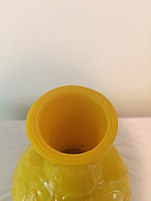Peking glass

Peking glass, also known as Kangxi Glass, Qianlong Glass or Tao Liao Ping,[clarification needed] is a form of Chinese glassware that originated in 18th century Beijing, China (then romanized as "Peking" in European writings). Originally used in the fabrication of glass snuff bottles, Peking glass has since been appropriated for a number of uses and continues to be produced in China.
History
[edit]Peking glass originated in 18th century China during the rule of the Qing dynasty. While China had long been a major producer of glassware, the introduction of European technologies to Asia in the 17th century caused a shift in the styles of Chinese glass makers. The principle couriers of these technologies were Jesuit missionaries, who introduced modern glass-making methods from Italy to China, which was at the time closed to the West. The advances spurred by the Jesuits led the Kangxi Emperor to establish an Imperial glass-works in 1696 to better produce the new material. The glass was commonly used in snuff bottles and vases, where it was used to imitate the harder to work jade and other precious stones. Eventually, the process of creating Peking glass was spread outside of the imperial glass-works and into the general population, leading to many artisans adopting Peking glass as a medium. The golden age of Peking glass in China is widely cited as being the reign of the Qianlong Emperor in the mid-18th century.[1][2] Though the art-form declined after the 19th century, the production of Peking glass continued in China through the Republican period and into the present day.[3][4]
Creation
[edit]
Peking glass is an overlay carved glass created by layering material around a core, similar to cameo glass.[1] To create the overlay, a glass blower makes the shape, then dips the shape into a basin of liquid glass several times. This process creates multiple layers of glass that are then carved away to produce a textured image. Peking glass is often made with different colored layers of glass, creating contrast when the outer layers are carved away.[1][5] Historically, many pieces of Peking glass were made with yellow glass (dubbed "Imperial Yellow") due to the colors' strong association with the Qing Imperial clan of Aisin Gioro.[2]
Outside China
[edit]In the late 19th century, glass-works in Czechoslovakia produced imitation Peking glass beads for use as costume jewelry.[6]
References
[edit]- ^ a b c "About Peking Glass". www.scanlanfinearts.com. Retrieved 6 June 2017.
- ^ a b Moonan, Wendy. "ANTIQUES; Chinese Glass As Stepchild". Retrieved 6 June 2017.
- ^ Watt, James C. Y.; Sun, Zhixin Jason (2001). "Asian Art". The Metropolitan Museum of Art Bulletin. 59 (1): 25–27. doi:10.2307/3269166. JSTOR 3269166.
- ^ Nilsson, Jan-Erik. "Chinese Porcelain Glossary: Glass, Chinese (Peking Glass)". gotheborg.com. Retrieved 6 June 2017.
- ^ Liu, Lihong (1 January 2016). "Vitreous Views: Materiality and Mediality of Glass in Qing China through a Transcultural Prism". Getty Research Journal. 8: 17–38. doi:10.1086/685913. ISSN 1944-8740. S2CID 191714213.
- ^ "What is Czech Peking Glass?". www.shopvjt.com. Archived from the original on 31 January 2016. Retrieved 3 July 2017.
